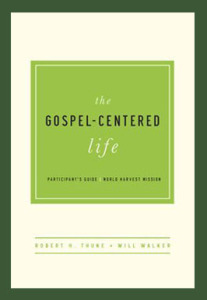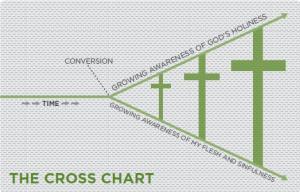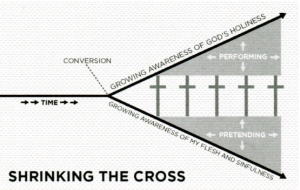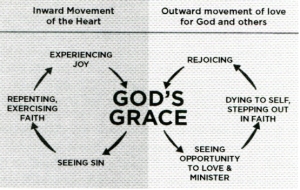 Now that we’re a bit better at gospeling ourselves, thanks to Joe Thorn’s Note to Self (yeah, that’s gospel as a verb), we can look at another standard work on the Gospel-Centered Everything bookshelf . The Gospel-Centered Life (GCL) is a nine-lesson small group study and a helpful resource for individuals. There is also a Gospel-Centered Life Leader’s Guide. These books are authored by Will Walker and blogger/writer, Bob Thune, one of the pastors at Coram Deo Church Community (yeah, you read that church name right and the word order is significant).
Now that we’re a bit better at gospeling ourselves, thanks to Joe Thorn’s Note to Self (yeah, that’s gospel as a verb), we can look at another standard work on the Gospel-Centered Everything bookshelf . The Gospel-Centered Life (GCL) is a nine-lesson small group study and a helpful resource for individuals. There is also a Gospel-Centered Life Leader’s Guide. These books are authored by Will Walker and blogger/writer, Bob Thune, one of the pastors at Coram Deo Church Community (yeah, you read that church name right and the word order is significant).
I’ve been known to claim GCL is the closest thing to a perfect book I’ve come across in a long time — I’m being mildly hyperbolic. The authors are successful in accomplishing what they set out to do in an understandable and well-written booklet, at about a sixth grade reading level, while quoting the Scriptures, Martin Luther’s commentary on Romans, and other Christian thinkers. So, when I go through The Gospel-Centered Life for the fourth time, I’ll be focusing a lot of attention on how they did what they’ve done, so that I can do what they do, when I’m getting some writing done!
From the back cover :
Build Gospel DNA in Your Small Group. Lots of Christians talk about the gospel, but how many really understand the gospel and know how to apply it to their lives? This nine-lesson small group study will help participants understand how the gospel shapes every aspect of life.
The authors’ aim is to help the reader:
- Deepen your grasp of the gospel as you see your need for continual renewal.
- Grow as you experience transformation from the inside out.
- Be challenged to develop authentic relationships as the gospel moves you to love and serve others.
The book is organized into nine lessons, grouped under three themes:
- What is the gospel?
- What does the gospel do in us?
- How does the gospel work through us?
Chapter one introduces the reader to the Big Idea: The Gospel Grid. This is the framework the book builds on:
If the gospel is constantly “bearing fruit and growing” (Col. 1:6), then everything has to do with the gospel — God, humanity, salvation, worship, relationships, shopping, recreation, work, personality … everything! The objective … is to establish a framework for talking about the gospel.
The gospel grid helps us to discover if the gospel and the cross are growing larger in our lives and transforming us into Christ’s likeness or if, heaven forbid, we are shrinking the cross through pretending and performing, transforming the gospel into a grace + works, pull-yourself-up-by-your-own-bootstraps, self-salvation project. So, the first three chapters focus on the gospel, before moving out into the areas of law & gospel, repentance, idolatry, forgiveness, conflict and mission. At every step of the way, we learn to pass everything through the gospel grid, “seeing more of God’s holiness and more of my sin.” As we focus on the cross and how Jesus dealt with that great divide between God’s holiness and our wretchedness, the good news of the cross grows larger and larger in our hearts, minds, and lives, transforming us from the inside out.

The authors include a number of simple illustrations to help visualize how our belief in the good news grows the cross, over time, while subtle unbelief shrinks or minimizes the cross and its transforming power in our lives.
The gospel centered life is a lifestyle — a day to day cycle of faith and repentance, always oriented toward God and not ourselves. We repent because we are truly sorry — not just for our actions, but for the sin-begetting unbelief and idolatry in our hearts. The gospel centered life looks to Jesus and His cross for deliverance from both the penalty and the power of sin: not our pretending and performing.

As we move forward with the gospel at the center, our hearts are moved by God’s grace to see our sin and repent, believing the good news that Christ paid our debt fully, so we can experience the joy of living in God’s presence. By grace, God shows us opportunities to love others by dying to ourselves and stepping out in faith. We rejoice in what God is doing in us and in others.

The Gospel-Centered Life is probably most effective in groups of five to ten people, who are willing to be transparent and extend grace to others. The Leader’s Guide is very effective in drawing participants out of themselves and into discussion. So, don’t be surprised if even the most mature believers in the group are shocked to discover that they have become very effective cross-shrinkers over the years. But, the gospel is always there to bring us full circle, giving us a proper perspective of the cross, how we relate to it, and where we stand with God, through Jesus Christ.
If you are a pastor or church-planter and plan to launch small groups or missional communities, taking them through The Gospel-Centered Life is the place to begin, erecting a framework for fruitful community that finds its identity in Jesus, through the gospel. With existing groups, this study provides an excellent corrective or reorientation, from time to time.
Maybe I’m just simple, but I keep going back to the GCL and love returning to the gospel:
Now I would remind you, brothers, of the gospel I preached to you, which you received, in which you stand, and by which you are being saved, if you hold fast to the word I preached to you—unless you believed in vain. For I delivered to you as of first importance what I also received: that Christ died for our sins in accordance with the Scriptures, that he was buried, that he was raised on the third day in accordance with the Scriptures
(1 Corinthians 15:1–4 ESV)
Be First to Comment